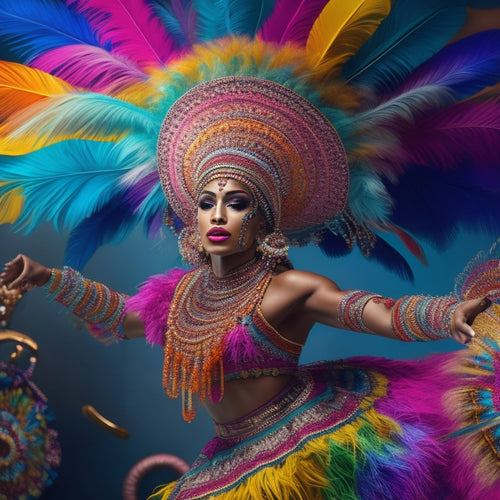
The Power of Dance: From Fitness to Worship
Share
Dance is a multifaceted phenomenon that transcends borders, cultures, and purposes, serving as a powerful medium for physical fitness, spiritual expression, and cultural identity. From alleviating stress and anxiety through dance therapy to providing a low-impact, calorie-burning alternative to traditional gym workouts, dance has evolved as a fitness regimen. Beyond physical health, dance is integral to devotional expression in various religions, fostering spiritual connection and ecstasy. Its cultural significance extends to preserving traditions, shaping identities, and storytelling. As we explore the power of dance, we unravel the intricate threads that weave together its profound impact on our lives.
Key Takeaways
• Dance offers a holistic approach to fitness, combining physical exercise with mental well-being and socialization.
• Dance serves as a means of spiritual expression and worship in various religious practices, fostering spiritual connection and ecstasy.
• Through cultural heritage, dance preserves traditions, shapes identities, and tells stories of indigenous rituals and cultural struggles.
• As a universal language, dance transcends borders, evolving over time to reflect diverse cultural influences and expressions.
• From fitness to worship, dance provides a multifaceted platform for self-expression, social connection, and spiritual growth.
Dancing for Fitness and Fun
What makes dancing an increasingly popular choice among fitness enthusiasts is its unique ability to simultaneously provide a great full-body workout while being an enjoyable and entertaining activity.
Through dance therapy, individuals can improve their mental health by reducing stress and anxiety while boosting mood and self-esteem.
Additionally, dance classes offer a socializing platform, allowing individuals to connect with like-minded people, build relationships, and develop a sense of community.
As a form of exercise, dancing provides a low-impact, calorie-burning alternative to traditional gym workouts, making it an attractive option for those seeking a fun and engaging way to stay fit and healthy.
Dance in Religious Practices
Beyond its physical and social benefits, dance has also played a significant role in various religious practices across cultures, often serving as a means of worship, expression, and spiritual connection.
In many religions, dance is an integral part of devotional expression, used to convey divine praise and reverence. Ritual movements, such as the Whirling Dervishes in Islam, create a sense of spiritual connection and ecstasy.
Similarly, in Hinduism, dance is an essential aspect of worship, with intricate movements and gestures used to honor deities. Through dance, individuals can transcend the mundane and connect with the divine, fostering a deeper sense of spirituality and devotion.
The Cultural Significance of Dance
Throughout history, dance has been an integral part of cultural heritage, playing a significant role in shaping identities, preserving traditions, and fostering community bonds. It's a universal language that transcends borders, with various forms and styles evolving over time. The cultural significance of dance is undeniable, with many Indigenous rituals and cultural traditions centered around dance.
| Cultural Tradition | Description |
|---|---|
| Indigenous Rituals | Dance is an integral part of Indigenous rituals, used for storytelling, healing, and spiritual connection. |
| African Diasporic | Dance is a crucial part of African diasporic culture, reflecting the struggles, triumphs, and cultural heritage of the African people. |
| Latin American | Dance is a vibrant expression of Latin American culture, with styles like salsa, rumba, and tango showcasing the region's rich heritage. |
| Asian Classical | Asian classical dance forms, such as Bharatanatyam and Kabuki, are deeply rooted in cultural traditions and mythological stories. |
| Global Fusion | Global influences have led to the evolution of dance, with fusion styles like hip-hop and contemporary reflecting the diversity of modern culture. |
Frequently Asked Questions
What Is the Ideal Age to Start Taking Dance Lessons?
As tiny toes twirl and little feet stomp, the ideal age to start taking dance lessons is as early as 2-3 years old, under parental guidance, fostering a lifelong passion and foundation for future mastery.
Can People With Disabilities Participate in Dance Exercises?
People with disabilities can participate in dance exercises through accessible choreography and inclusive studios, offering modified movements and adaptive techniques to guarantee equal opportunities for physical expression and creative empowerment.
How Do Professional Dancers Prevent Injuries While Performing?
As a dancer's limbs unfold like a blooming flower, injury prevention becomes paramount. Professional dancers prioritize proper alignment, incorporating cross-training exercises to strengthen core muscles, ensuring a resilient foundation for their artistic expression.
Are There Any Dance Styles That Can Help Improve Mental Health?
Certain dance styles, such as Mindful Movement, incorporate Emotional Expression to improve mental health by promoting relaxation, reducing anxiety, and fostering self-awareness, leading to a more balanced and centered state of being.
Can Dance Be Used as a Form of Therapy for Stress Relief?
According to the American Council on Exercise, 70% of dance participants report reduced stress levels. Dance can be a therapeutic outlet for stress relief, promoting Mindful Movement and Emotional Expression, allowing individuals to release tension and channel emotions in a healthy, constructive manner.
Related Posts
-

What Makes a Stunning Lyrical Dance Makeup Look?
You craft a stunning lyrical dance makeup look by balancing ethereal, emotive essence with subtle, shimmering accents...
-

Legal Battle: TikTok's Makeup Looks Ownership Uncertainty
TikTok's rise in popularity has sparked a legal battle over makeup looks ownership, leaving creators vulnerable to ex...
-

Moo! Unveiling Latin Dance Culture Sensation
Latin dance culture is a vibrant phenomenon that embodies the essence of identity, community, and self-expression, re...


